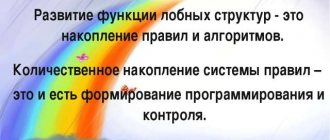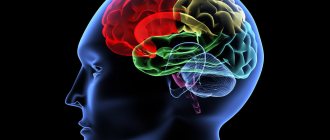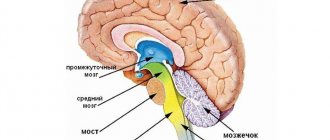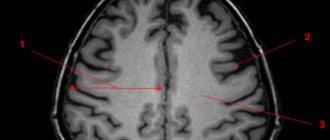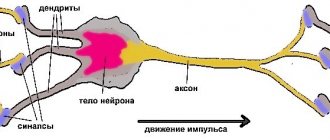And now with words.
In each test we check the dominant leg, arm, eye, side of the body. Each hemisphere controls the opposite side, therefore, if the right hand is dominant in a test, then in this test we consider the left hemisphere to be dominant, and vice versa. With the eyes, everything is more complicated, so in the seventh test, if the right eye reacted first, we note the dominance of the right hemisphere.
For the left hemisphere write the letter “L”, for the right - “P”, if in some test they are equivalent - o (zero).
- Interlocking fingers. Interlace your fingers as in the picture. Which thumb is on top? Label the opposite hemisphere as dominant.
- Rosenbach's test. Only 10% of people manage not to be stupid in this test. Take a pencil in your hand, hold it out in front of your eyes and aim at it. Close one eye, then the other. When closing which eye, the image shifts more (relative to the sight with both eyes)? Mark the opposite hemisphere as dominant in this test. If it moves the same or does not move, set it to zero.
- Napoleon pose. Cross your arms over your chest. Which hand rests on top of the other's forearm? Right - put "L", left - "P".
- Applause. Applaud with one hand on top. Which? Mark the opposite hemisphere.
- Cross your legs. Which leg is on top? The first reaction is important. Mark the opposite hemisphere.
- Wink. Which eye? If you are right, mark the right hemisphere; if you are left, mark the left.
- Get off your lazy ass and spin around on your own axis. Which way? Counterclockwise is left, clockwise is right.
- Now take an unlined piece of paper and a pen. Draw a vertical line dividing the sheet into two parts. Which part was larger? Mark the opposite hemisphere. Identical - put zero.
- Triangles and squares. Using each hand, draw three triangles and three squares on each side of the paper. Which ones are better? Mark the opposite hemisphere. Make a small allowance for untrained hands.
- Strokes. Here, too, for some reason everyone is stupid. With each hand, not counting, draw a series of vertical strokes (there is an example in the picture). Then you count the strokes. Which hand did you draw more? Mark the opposite hemisphere. If they are the same or approximately the same, mark zero.
- Using your normal hand, draw a circle and end the line with an arrow. If you drew it counterclockwise, oh, clockwise - “P”.
What does this or that result mean?
Warning. Everything that will be written next is taken from scientific and popular science literature (sources are listed at the end). But the brain is a very complex thing, so you don’t need to perceive everything as unambiguously as it is described.
If you have incomplete dominance of one hemisphere, then you can act as both a “left-brain dominant” person and a “right-brained” person (the terms are crude, but easier to write than “left-brain dominant people”, but since I am the author of the article, so I will write as it suits me). By the way, these are the majority.
The following describes the principles by which each hemisphere works; they are more pronounced in people who exhibit complete dominance of one of the hemispheres. Personally, I am very left-brain dominant, in case anyone is curious (I know, no one).
To begin with, here is a quote from a study using the electric shock method, in which only one hemisphere of the subjects remained “on” (for medical reasons):
A “left-hemisphere” person suffers from types of mental activity associated with imaginative thinking: he does not perceive the intonation composition of speech, melodies, is talkative, has a rich vocabulary, the types of mental activity that underlie abstract thinking are enhanced: there is a tendency to classification. Differs in a positive emotional tone. A “right-hemisphere” person demonstrates a sharp decrease in speech abilities, classification is impaired, is more readily explained by facial expressions and gestures, and is good at distinguishing changes in intonation. Differs in imaginative thinking. Negative emotions predominate.”(1)
And now a little more about what the quote says.
The mystery of the cerebral hemispheres
Mysteries of the brain: the mystery of the two hemispheres
Our time is an era of amazing discoveries: deciphering the genome, cloning, organ transplantation... But the highest mystery of nature still remains the human brain.
brain, self-knowledge
Our time is an era of amazing discoveries: genome decoding, cloning, organ transplantation. But back in the 30s of the last century, Academician I.P. Pavlov noticed: the progress of natural science for the first time noticeably stopped in front of the highest mystery of nature - the thinking brain. Cybernetics called the brain a black box. We know what information enters the brain, and we can judge how this responds to a person’s behavior, thoughts and feelings. But what's going on inside - in this box?..
The brain has two hemispheres: left and right. But they developed at different times: for millions of years people lived only with the right hemisphere, and then another one appeared, which complicated the picture. It turned out that these two hemispheres are completely autonomous. They “speak” different languages and, as a rule, do not hear each other.
University of California scientist Robert Ornstein has proven that if the “weaker” hemisphere is stimulated and involved in work together with the “stronger” (leading), the effectiveness of human activity increases by 5-10 times.
Speech
The left hemisphere is verbal, it contains the center of speech, therefore left-hemisphere people are talkative. Ask me anything on a topic that interests me, and in a couple of minutes you will regret it. But at the same time, the right hemisphere is responsible for the emotional coloring of speech and intonation. In this vein, it is interesting to remember this. Owners of cats or dogs know that if you call your pet a bad word but affectionately, he will think that you are praising him. And why? Because there is no speech, but he picks up intonations. If the same is done to a person, he will be somewhat confused.
Verbal-nonverbal hemispheres are ambiguous. The left hemisphere is activated when reading scientific texts, and the right hemisphere is activated when reading literary texts. The right hemisphere is sensitive to humor and understands metaphors. (2) I am left-brained, so my metaphors are like oil spilled on the sea.
Developing the right hemisphere of the brain
The human brain consists of the right and left hemispheres. The hemispheres receive information in a mirror way, which means the left hemisphere processes information from the right side of our body, and the right hemisphere from the left. Therefore, it is generally accepted that a right-handed person has a more developed left hemisphere, while a left-handed person has a more developed right hemisphere. The left hemisphere is responsible for logic and analytical information processing abilities, while the right hemisphere is responsible for fantasy and creativity. Proof of this is Rubens, da Vinci, Michelangelo, Alexander Pushkin, Leo Tolstoy, Hans Christian Andersen and many other famous left-handers. Scientists have found that the right hemisphere is dominant in children from birth. Modern schools are designed in such a way that the left hemisphere draws all attention to itself, gradually suppressing its neighbor, the right hemisphere. Which hemisphere is dominant in a person is immediately clear. This affects his personal characteristics: left-hemisphere people are drawn to science, right-hemisphere people are drawn to creativity and art.
Interesting fact: Scientists have found that using the left hand as a leading hand is associated with a peculiarity of brain function. When moving the leading hand, a right-handed person uses the left hemisphere, while a left-handed person uses both hemispheres.
Why develop the right hemisphere.
Basically, the right hemisphere is responsible for fantasy, intuition, the ability to look at a situation from different sides, to see the complete picture of the world. In addition, the right hemisphere has its own set of functions, which a person cannot do without: spatial thinking, musicality, dreams, artistic abilities, development of cognitive functions. With the harmonious development of both hemispheres of the brain, the child grows up confident, creative, and diversified.
How to develop the right hemisphere.
You can develop your brain in the same way as your body: with the help of exercises and gymnastics. Children learn everything through play, so there are many play exercises to develop the right hemisphere. 1. Ring: Take turns, gradually increasing speed, move the fingers on your left hand, connecting them into a ring with your thumb. First, connect the thumb to the index finger, then the thumb to the middle finger, the thumb to the ring finger, and finally the thumb to the little finger. Then you start in reverse order. You can make the exercise more difficult by moving and connecting the fingers on both hands at the same time. 2. Game Captain: We put our right hand with a “visor” to the eyebrows, with our left hand we show the “Class” sign, then we change hands. Over time, we complicate the task by adding clapping of palms between changing hands. 3. Exercise fist - palm - edge: Alternately, the child performs 3 movements: 1 - clenches the palm into a fist, 2 - places the edge on the table, 3 - places the hand palm down. At the beginning, the exercise is done with the right hand, then with the left, then with both at the same time. 4. First Aid: To play, you will need a piece of paper with the alphabet written on it. Under the letters of the alphabet, we write L P V, alternating. For example, A - under it we write L, B - under it P, C - under it C, G - under it again L, and so on. The letters L P V indicate actions: L - raise your left hand, P - raise your right hand, V - raise both hands. The upper letter of the alphabet is pronounced, the lower one indicates an action: the child says A - raises his left hand and lowers it, says B - raises his right, etc. We perform the exercise from the first letter to the last, and start in reverse order. Over time, the speed of the exercise increases. 5. For older right-handed children, print out copybooks and coloring pages, asking the child to use their left hand to color and write.
Right hemisphere drawing
Right hemisphere drawing is a drawing method for developing the right hemisphere. In 1979, Betty Edwards, PhD, developed the right-brain drawing method. The work of the right hemisphere is called “P - mode”, the left hemisphere is called “L - mode”. Right-hemisphere drawing is working in the P-mode, where the left hemisphere is consciously suppressed. 1. “Inverted drawing” is one of the right-hemisphere drawing techniques. The essence of the exercise: print out the outline drawing, as in a coloring book, and turn it over. Invite your child to transfer the contours to another sheet of paper, copying each line, and not the entire image with details. 2. “Mirror drawing” is a method in which a child can draw one picture with both hands at the same time. It is used in 2 ways: 1. the child traces the drawing with both hands at the same time 2. draws independently, also with both hands at the same time. The method of drawing with both hands at the same time is more difficult, so it is recommended to start with the first. The method helps schoolchildren develop a sense of symmetry and is used in art therapy to relieve anxiety.
The right hemisphere is responsible for speech, associations, metaphors. If a child’s left hemisphere is naturally dominant, and he is right-handed, then the development of the right hemisphere will be useful for school - drama clubs, school essays, literature lessons, drawing, and also in general for the development of a harmonious personality.
Music
The left hemisphere does not perceive music; the right hemisphere is responsible for it. On the other hand, I came across information that the corpus callosum (it connects the hemispheres) is better developed in musicians than in people not involved in music. That is, musicians' hemispheres work more harmoniously. I found the same thing when I was doing research at university. Among music school students there were significantly more people with incomplete dominance of the right hemisphere than in the control group. In the control group, students with incomplete dominance of the left hemisphere predominated.
Exercises to activate the right hemisphere
"Recommendation. Intuition, internal imaginative vision, an integrated approach - all these manifestations of right-hemisphere thinking can be developed. You can do this either independently (using the well-known methods of Heinrich Altshuller, Edward de Bono, Michael Mikalko, Tony Buzan, Julia Cameron, Merilee Zdenek and others), or you can do intensive creativity training in a group at a special training.”
Start training the right hemisphere with simple exercises that are performed in pairs.
- Exercise "Images". Sit comfortably and close your eyes. Concentrate on your breathing: breathe deeply, becoming more calm with each breath and focusing on your own sensations. Inhale and exhale easily and freely. Feel that you are warm, cozy, comfortable and that you are breathing in clean, fresh and cool air. This way you calm down and get ready for a new type of activity. Now your partner will slowly read out the words that you need to feel, feel as realistically as possible. Focus on the content of the words. Say the words to yourself and imagine what you hear in your imagination.
First, visual images : banana, river, forest, flower, bee, red, game, affectionate, tinker, weave.
Next are auditory images : the sound of the sea, the sound of a moving tram, the sounds of a piano, the ringing of a bell, gusts of wind, falling drops, chirping sparrows, echo, whisper.
Bodily images : stroking fur, melting snowflake, warm steam, walking on a soft carpet, hot water, sharp needle, fish scales, soft fluff.
And in the end - olfactory and tactile images : the aroma of a fresh rose, the smell of hay, the smell of pine needles, the taste of a freshly cut orange, a slice of chocolate, a canapé with large red caviar.
- Exercise "Proverbs". Your exercise partner makes a wish for some well-known proverb or saying and tries to explain silently, non-verbally (only with the help of facial expressions and gestures) what he wished for. You're guessing. Then you switch roles.
Good luck in developing right-brain thinking! Your opinion: how is right-hemisphere, intuitive-imaginative thinking related to leadership?
Author: Oksana Sedashova
We also recommend reading:
- Storytelling
- Creativity and logic: the myth of functional asymmetry of the cerebral hemispheres
- Brain structure
- Intelligence and its development: several recommendations
- Digest: critical thinking
- Logic vs intuition
- Thinking techniques
- How and why to develop thinking
- Development of thinking: ways to train the brain
- Types of thinking
- Brain development: useful tips and exercises
Key words:1Cognitive science



